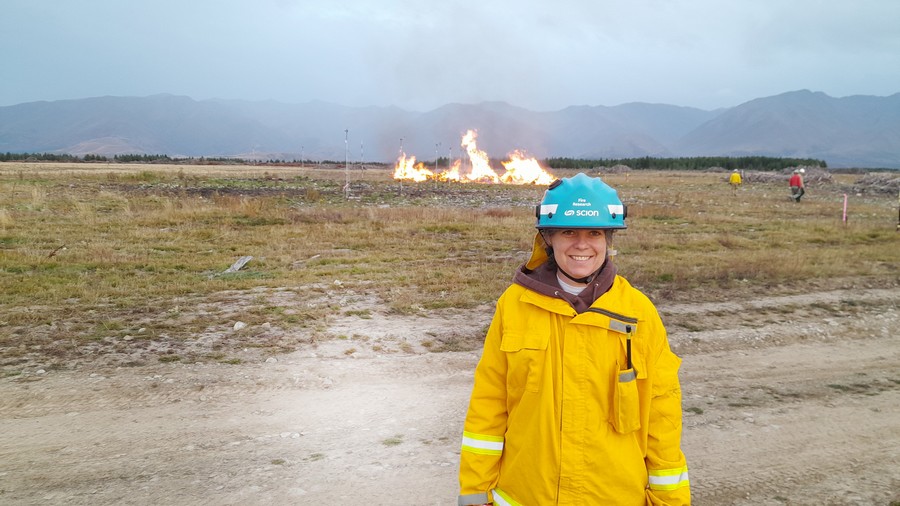Watch this space: Scion working with NASA
Scion scientists are collaborating with NASA research centres on fire, drought and water research.
Scion researchers have secured government support to collaborate with NASA research centres to observe and learn from how water flows through forests and investigate wildfire and drought risks from space.
The Scion teams are among 12 from nine research institutes, each funded up to $75,000 from the Government’s Catalyst Fund for six-month Earth observation feasibility studies. Scion’s two research projects, which started on April 1, will explore water use as well as wildfire and drought risks alongside two National Aeronautics and Space Administration (NASA) research centres. Collaborating will give the teams access to state-of-the-art technology and expertise to develop their research and build partnerships with a world leader in space research.
The water-use study will build on results from Scion’s MBIE-funded Forest Flows programme, which has researched forest hydrology in sites around New Zealand.

One of the study sites, an 1800-hectare research catchment in Te Hiku Forest on Northland’s Aupōuri Peninsula, will be the focus of the work with NASA’s Jet Propulsion Laboratory and the University of Massachusetts at Amherst.
The research team will use two NASA satellite missions to generate forestscale measurements of surface and soil water, two key components of the forest water cycle.
The satellite missions will be the new Surface Water and Ocean Topography, and the joint NASA-ISRO Synthetic Aperture Radar. The missions will measure water use and movement from a single tree (small-scale) up to an entire forest (large-scale).
If successful, the research could be applied across the peninsula’s multiple land uses, and even globally across different land uses at different scales, science lead Dean Meason says.
Tangata whenua Te Hiku ō Te Ika Iwi and the local community are concerned about the potential impact of Te Hiku Forest, planted with radiata pine, on the amount of water in streams and dune lakes, Meason, who is based in Scion’s Rotorua head office, says. “Alongside showcasing New Zealand research, this provides the opportunity to answer these pressing local concerns about water use and availability and increase understanding of water use and water flow to waterways throughout Te Hiku Forest.”
Identifying at-risk areas
The other funded study will develop a roadmap to build a real-time fuel moisture and fuel type system. It is a collaboration led by Scion with NASA’s Ames Research Center, Australian National University, the US Forest Service, Fire and Emergency New Zealand, and the University of Canterbury. The collaborative team includes world-class experts in wildfire, remote sensing, fuel moisture, risk management, and ecology, including Scion’s Christchurch-based staff.
Accurate data on the moisture content within living vegetation, known as fuel moisture, can provide information on how fire could spread through vegetation and identify areas where drought-stressed vegetation is at risk from insects and disease. Developing a roadmap is the first of three phases and will lay the groundwork for the development of a publicly accessible realtime moisture prediction tool.
“This work will provide the initial resources needed to build long-term capability and develop new research ideas and direction for wildfire and drought risk management both in New Zealand and internationally,” Scion fire ecologist and science lead Shana Gross says.
While scientists have been using remote sensing to evaluate fuel characteristics since the 1980s, rapid improvements in satellite technology provide new opportunities to explore complex problems.
Historically, fuel moisture has been evaluated in isolation without up-to-date spatial characterisation of the fuel type. This limits the accuracy of current fire prediction tools. By combining fuel moisture with information on fuel type, the work could lead to more accurate wildfire predictions, improving warning systems and reducing economic and environmental loss due to wildfire and drought.
Completed feasibility studies will be considered by the Ministry of Business, Innovation and Employment and NASA for second stage funding which offers up to $5.6m over three years to fund progressing up to five feasibility studies into longer-term collaborative research projects.
Catalyst: Strategic – New Zealand – NASA Research Partnerships 2023 funding helps New Zealand build a strategic relationship with NASA through global research while unlocking information about the environment and climate through high-altitude and space observations.
